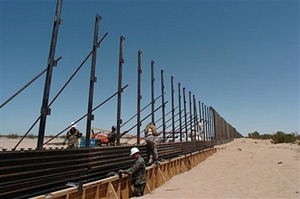 |
 |
 |
 News from Around the Americas | June 2006 News from Around the Americas | June 2006  
US Troops Reducing Illegal Border Crossings
 Olga R. Rodriguez - Associated Press Olga R. Rodriguez - Associated Press


| | Members of the National Guard work on construction of a border wall at the U.S.-Mexico border next to San Luis Rio Colorado, Mexico on Thursday, June 8, 2006. Photo was taken from a few steps into the United States. The arrival of U.S. National Guard troops in Arizona has scared off illegal Mexican migrants along the border as a whole, significantly reducing crossings, according to U.S. and Mexican officials. (AP/David Maung) |
The arrival of U.S. National Guard troops in Arizona has scared off illegal Mexican migrants along the border, significantly reducing crossings, according to U.S. and Mexican officials.

U.S. authorities said Monday that detentions along the U.S.-Mexico border decreased by 21 percent, to 26,994, in the first 10 days of June, compared with 34,077 for the same period a year ago.

Along the Arizona border, once the busiest crossing spot, detentions have dropped 23 percent, according to the U.S. Border Patrol.

Detentions dropped 31 percent, to 8,308 from 11,977, along the Texas and New Mexico border.

The desert region's blistering June temperatures typically drive down the number of migrants, but not so drastically, said Mario Martinez, a spokesman with the U.S. Border Patrol in Washington.

The 55 Utah soldiers who arrived June 3 are the first of some 6,000 troops to be dispatched along the border as part of President Bush's plan to stem illegal immigration to the United States.

The soldiers aren't allowed to detain migrants and have been limited to projects like extending border fences and repairing roads, but the military's presence is keeping would-be crossers away from the area, migrant rights activists said.

Francisco Loureiro, who runs a migrant shelter in Nogales, Mexico, across the border from Arizona, said migrants are afraid of the U.S. troops after hearing reports of abuse in Iraq.

"Some migrants have told me they heard about the troops on television and, because the U.S. Army doesn't have a very good reputation, they prefer not to cross," Loureiro said. Others have been discouraged by smugglers' fees that have nearly doubled to more than $3,000.

Jorge Vazquez, coordinator for Mexico's Grupo Beta migrant aid agency in San Luis Rio Colorado, across from San Luis, Ariz., said that before the troops arrived, his agents encountered at least two dozens migrants daily, most waiting for nightfall to begin their trek through the sandy desert.

"There have been days ... when we've found only three migrants," Vazquez said.

Some migrants may be moving to the California-Mexico border, the only stretch of border that saw a spike in detentions, which were up 7 percent to 5,965 in the first 10 days of June.

But it was too early to tell if the deployment would have a permanent effect on migrant routes and crossings of the 2,000-mile border.

Wearing Army fatigues and hard hats, the soldiers have worked on projects such as installing vehicle barriers to help prevent smugglers from driving cars full of migrants or drugs across the border.

Arizona Gov. Janet Napolitano has said 2,500 troops will be stationed in the four U.S. border states - Arizona, California, New Mexico and Texas - by the end of the month.

The deployment plan has been criticized in Mexico as heavy-handed, and the Mexican government has said it will watch to ensure National Guard troops aren't detaining migrants.

Only the most persistent migrants remained in San Luis Rio Colorado, which sits across from the area patrolled by the U.S. Border Patrol's Yuma station, the busiest of the Patrol's 143 outposts.

Migrants in the region walk some 25 miles through the scrub-covered desert with summer temperatures often exceeding 100 degrees, and then hop on cargo trains to reach their destination.

Laureano Miranda, a 37-year-old farm worker from Mexico's Sinaloa state, said he was trying to get back to a construction job in Los Angeles.

Miranda and six relatives, who were sewing pieces of carpet to their shoes to avoid leaving footprints, planned to wait for nightfall and start walking across the border 25 miles west of where the troops were stationed.

Miranda, who earned about $6 a day picking tomatoes in Sinaloa, said he had heard about the deployment but planned to cross into Arizona anyway.

"If there are soldiers or not it's the same thing, because it's always been difficult to cross," Miranda said. "Here, we depend on our luck."

Miranda said he made it into the United States on the first try last year, but he expected a more difficult journey this time.

"We've heard that there are soldiers and armed 'migrant hunters' but we have to try," Miranda said. "If we don't make it in three tries, then we'll go back home."

On the Net: U.S. National Guard: http://www.arng.army.mil U.S. Border Patrol: http://www.cbp.gov/ | 
 | |
 |



